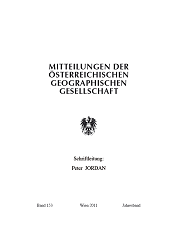
Mitteilungen der Österreichischen Geographischen Gesellschaft Band 153/2011, pp. 129-164, 2012/03/28
153. Jg. (Jahresband), Wien 2011
Der vorliegende Beitrag stellt eine neue wirtschaftsräumliche Gliederung Österreichs vor, die eine direkt vergleichbare Aktualisierung der im Jahre 1979 publizierten Österreich-Atlas-Karte „Wirtschaftliche Strukturgebiete auf Grund der Arbeitsbevölkerung und Pendlerbilanz“ darstellt. Auf Basis gemeindeweiser Beschäftigungs- und Tourismusdaten wird Österreich nach genau festgelegten Regeln (vgl. Bobek & Hofmayer 1981) in wirtschaftsstrukturelle Regionen (ca. 200 Gebiete) gegliedert, die hinsichtlich Sektoralstruktur der Beschäftigten, Tourismusintensität und Arbeitsplatzausstattung möglichst homogen sind. Die neue Karte wurde im Rahmen einer Dissertation an der Wirtschaftsuniversität Wien von Huberta Kulmhofer (2009) erarbeitet. Dieser Beitrag bietet nach einer kurzen Deskription der neuen Regionalisierung eine Auswertung in zweierlei Richtung: 1) Überprüfung der von H. Bobek aus der früheren Karte abgeleiteten Aussagen über das Raummodell der Strukturgebiete und die Standorttendenzen der Wirtschaftssektoren; 2) Intertemporaler Vergleich der räumlich-sektoralen Struktur ausgewählter Wirtschaftsräume: Zentralräume, ehemalige Agrarräume, Tourismusräume. Ad (1): Es wird ein prinzipielles Weiterbestehen des Bobek‘schen Raumstrukturmodells der Hauptregionen Österreichs festgestellt, wobei sich aber das Gewicht der einzelnen Strukturtypen stark verschoben hat und ein völlig neuer Strukturtyp im Umland der Hauptregionszentren entstanden ist. Ad (2): Aus den drei genannten Kategorien von Wirtschaftsräumen werden jeweils zwei Beispielsräume einander gegenübergestellt (Wien – Linz; Waldviertel – Südostösterreich; Salzburg – Kärnten). Mittels visuellen Vergleichs von intertemporalen Kartenpaaren werden sowohl Gemeinsamkeiten als auch Sonderentwicklungen der räumlichsektoralen Entwicklung aufgezeigt, welche Anregung für weitere Forschungen bieten.
...
A new economic regionalisation of Austria – update of a thematic map published 30 years ago in the ‘Österreich-Atlas’
This paper presents a new subdivision of Austria into economic regions, comparing it to the map ‘Economic regions on the basis of employment structure and workplace balance’ published in 1979 in the ‘Österreich-Atlas’ (Atlas of the Republic of Austria). Using occupational and tourism statistics by communes, and following a method described in Bobek & Hofmayer 1981, Austria is subdivided into approx. 200 regions of maximum homogeneity with respect to sector structure of employment, intensity of tourism and workplace balance. The new map was elaborated by Huberta Kulmhofer (doctoral dissertation at the University of Economics Vienna, 2009). After a short presentation of the new regionalisation, this paper focuses on two topics: 1) Critical check of H. Bobek’s findings derived from the map of 1979 concerning the spatial-structural model of the economic regions and the location tendencies of the main economic sectors (agriculture, manufacturing, services); 2) Cross-temporal comparison of spatial-economic structure of selected parts of Austria: central areas of the ‘Länder’, former agricultural areas, touristic areas. Concerning (1) it is argued that Bobek’s spatial-structural model is still applicable to Austria’s territory; nevertheless, a strong shift in the relative weight of the individual types of economic structure did occur, and a new structure type in the suburban zone of the large regional capitals emerged. With respect to (2), for each of the three categories of economic structure two sample areas were selected (Vienna [Wien] – Linz; Waldviertel – South-eastern Austria; Salzburg – Carinthia [Kärnten]). By way of a visual comparison of the cross-temporal map pairs both similarities and dissimilarities of the spatial-structural development patterns are revealed, and suggestions made for further research.